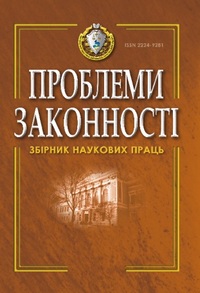Вплив земського самоврядування на процес формування вітчизняного конституціоналізму наприкінці ХІХ – початку ХХ століть
Influence of zemstvo self-government on process of national constitutionalism development in late XIX – early XX centuries
Author(s): Anatolij KozachenkoSubject(s): Law, Constitution, Jurisprudence, Constitutional Law
Published by: Національний юридичний університет імені Ярослава Мудрого
Keywords: constitutionalism; autonomy; democracy; zemstvo self-government; opposition; liberal-democratic movement
Summary/Abstract: Problem Setting. The article describes the activities of the zemstvo self-government which had a significant impact on the process of national constitutionalism development in the late XIX – early XX centuries. The actuality of the topic. Zemstvo self-government got significant practical experience of legal oppositional activity, which is an important element of constitutionalism. Within the territory of ethnicUkraine, zemstvo constitutionalism combined two components: All-Russian and national. The purpose of the article. All-Russian zemstvo constitutionalism had features of legal, semi-legal and illegal activities, which were represented by liberal and radical wing of zemstvo liberal-democratic movement respectively. In the All-Russian context, zemstvo radicals advocated the idea of establishing constitutional order in the Russian Empire, which involved constitutional recognition of democratic rights and freedoms, equality, parliamentary system and establishment of a constitutional monarchy, decentralization of power, political pluralism. The national component of zemstvo constitutionalism, which was formed at the beginning of the bourgeois-democratic revolution of 1905–1907, had illegal character and its essence can be described by the fact that some zemstvo liberals insisted on the need to restore the Ukrainian state in the form of autonomy within democratic Russia. Representatives of both components of zemstvo constitutionalism aimed to implement their constitutional ideas through reforms. Zemstvo constitutionalism reached its highest peak at the beginning of the bourgeois-democratic revolution of 1905–1907. In early XX century zemstvo liberals took active part in activities of bourgeois-democratic political parties. Development of Russian and Ukrainian political parties led to a split in the radical wing of zemstvo liberal-democratic movement on the national basis. Some zemstvo leaders joined the All-Russian Party of Octobrists and Constitutional Democrats. Head of Poltava provincial board F. A. Lyzohub was a well-known figure in the Party of Octobrists. P. Chyzhevskyi and M. Rusov became active participants of the Ukrainian Democratic-Radical Party and the Revolutionary Ukrainian Party respectively. The Sheremet brothers were members of the Ukrainian People’s Party. Conclusions. Some liberal zemstvo-constitutionalists who adhered to the moderate position raised the question of democratization of zemstvo self-government without changing the foundations of autocratic regime. They took shape of the moderate wing of zemstvo liberal-democratic movement. To democratize zemstvo self-government, the main course of zemstvo-constitutionalists’ activities consisted of the claims to the government to change the system of zemstvo bodies, reform of the electoral system, expand powers of zemstvo bodies, limit powers of local administration concerning control of zemstvo bodies’ activities.
Journal: Проблеми законності
- Issue Year: 2016
- Issue No: 132
- Page Range: 9-17
- Page Count: 9
- Language: Ukrainian

